
Guido Reni Painting Reproductions 1 of 1
1575-1642
Italian Baroque Painter
Guido Reni (4 November 1575 - 18 August 1642) was a prominent Italian painter of high-Baroque style.
Born in Bologna into a family of musicians, Guido Reni was the son of Daniele Reni and Ginevra de' Pozzi. As a child of nine, he was apprenticed under the Bolognese studio of Denis Calvaert. Soon after, he was joined in that studio by Albani and Domenichino. He may also have trained with a painter by the name of Ferrantini. When Reni was about twenty years old, the three Calvaert pupils migrated to the rising rival studio, named Accademia degli Incamminati (Academy of the "newly embarked", or progressives), led by Lodovico Carracci. They went on to form the nucleus of a prolific and successful school of Bolognese painters who followed Annibale Carracci to Rome. Like many other Bolognese painters, Reni's painting was thematic and eclectic in style.
Work in Rome
By late 1601, Reni and Albani had moved to Rome to work with the teams led by Annibale Carracci in fresco decoration of the Farnese Palace. During 1601-1604, his main patron was cardinal Sfondrato. By 1604-1605, he received an independent commission for an altarpiece of the Crucifixion of St. Peter. After a few year sojourn in Bologna, he returned to Rome to become one of the premier painters during the papacy of Paul V (Borghese). From 1607-1614, he was one of the painters patronized by Borghese.
Reni's frescoed ceiling of the large central hall of garden palace, Casino dell'Aurora located in the grounds of the Palazzo Pallavicini-Rospigliosi, is considered his masterpiece. The casino was originally a pavilion commissioned by Cardinal Scipione Borghese; the rear portion overlooks the Piazza Montecavallo and Palazzo del Quirinale. The massive fresco is framed in quadri riportati and depicts Apollo in his Chariot preceded by Dawn (Aurora) bringing light to the world. The work is restrained in classicism, copying poses from Roman Sarcophagi, and showing far more simplicity and restraint than Carracci's riotous Triumph of Bacchus and Ariadne in the Farnese. Reni in this painting is allies himself more with the sterner Cavaliere d'Arpino,Lanfranco, and Albani "School" of mytho-historic painting, and less with the more crowded frescoes characteristic of Pietro da Cortona. There is little concession to perspective, and the vibrantly colored style is antithetical to the tenebrism of Caravaggio's followers. Payments showed that he was paid in 247 scudi and 54 baiocchi upon completion on 24 September 1616.
He also frescoed in Paoline Chapel of Santa Maria Maggiore in Rome as well as the Aldobrandini wings of the Vatican. According to rumor, the pontifical chapel of Montecavallo (Chapel of the Annuciation) was assigned to Reni to paint. However, because he felt underpaid by the ministers, the artist left for Bologna, leaving the role of the preeminent artist in Rome to Domenichino.
Work in Naples and return to Bologna
In later years, Reni traveled to Naples to complete a commission to paint a ceiling in a chapel of the San Gennaro. However, in Naples, the other local prominent painters, including Corenzio, Caracciolo and Ribera, were vehemently resistant to competitors, and according to rumor, conspired to poison or otherwise harm Reni (as may have befallen Domenichino in Naples after him). He passed briefly by Rome, but left that city abruptly, during the pontificate of Urban VIII, after being reprimanded by Cardinal Spinola.
Returning to Bologna, more or less permanently, Reni established a successful and prolific studio. He was commissioned to decorate the cupola of the chapel of Saint Dominic in the Basilica of San Domenico in Bologna, between 1613 and 1615, resulting in the radiant fresco St Dominic's Glory, a masterpiece that can stand the comparison with the exquisite Arca di San Domenico below. He also contributed to the decoration of the Rosary Chapel in the same church with the Resurrection.
In Ravenna, he painted the chapel in the cathedral with his admired picture of the Israelites gathering Manna. Reni, after departing Rome, alternately painted in a variety of styles, true to the eclectic tastes of many of Carracci trainees. For example, his altarpiece for Samson Victorious formulates stylized poses characteristic of mannerism. In contrast his Crucifixion and his Atlanta and Hipomenes depict dramatic diagonal movement coupled with the effects of light and shade that betray the influence of Caravaggio. His turbulent and violent Massacre of the Innocents (Pinacoteca, Bologna) is painted in a manner reminiscent of Raphael. In 1625 Prince Wladyslaw Sigismund Vasa of Poland visited the artist workshop in Bologna during his voyage to Western Europe. The close rapport between the painter and the Polish Prince resulted in the acquisitions of drawings and paintings. In 1630, he painted the Pallion del Voto with images of St. Ignatius and Francis Xavier, painted during the plague of 1630 that attacked Bologna.
His most distinguished pupil was Simone Cantarini, named "Il Pesarese"; he painted a portrait of his master, now in the Bolognese Gallery. Other trainees were Domenico Maria Canuti and Giovanni Battista Michelini. The Uffizi Gallery holds a self-portrait. Other pupils were Giacomo Semenza, Francesco Gessi, and Marco Bandinelli. His themes are mostly biblical and mythological in subject. He painted few portraits; those of Sixtus V, Bernardino Cardinal Spada, and the so called Beatrice Cenci are among the most noticeable. The identity of the Cenci portrait is very doubtful, since Beatrice Cenci was executed in Rome before Reni ever lived there and so could not have sat for the portrait. Many etchings are attributed to Guido Reni, some after his own paintings and some after other masters. They are spirited, in a light style of delicate lines and dots. Reni's technique was used by the Bolognese school and was the standard for Italian printmakers of his time.
Reni died in Bologna in 1642.
He is buried with Elisabetta Sirani in the Rosary Chapel of the Basilica of San Domenico in Bologna.
Born in Bologna into a family of musicians, Guido Reni was the son of Daniele Reni and Ginevra de' Pozzi. As a child of nine, he was apprenticed under the Bolognese studio of Denis Calvaert. Soon after, he was joined in that studio by Albani and Domenichino. He may also have trained with a painter by the name of Ferrantini. When Reni was about twenty years old, the three Calvaert pupils migrated to the rising rival studio, named Accademia degli Incamminati (Academy of the "newly embarked", or progressives), led by Lodovico Carracci. They went on to form the nucleus of a prolific and successful school of Bolognese painters who followed Annibale Carracci to Rome. Like many other Bolognese painters, Reni's painting was thematic and eclectic in style.
Work in Rome
By late 1601, Reni and Albani had moved to Rome to work with the teams led by Annibale Carracci in fresco decoration of the Farnese Palace. During 1601-1604, his main patron was cardinal Sfondrato. By 1604-1605, he received an independent commission for an altarpiece of the Crucifixion of St. Peter. After a few year sojourn in Bologna, he returned to Rome to become one of the premier painters during the papacy of Paul V (Borghese). From 1607-1614, he was one of the painters patronized by Borghese.
Reni's frescoed ceiling of the large central hall of garden palace, Casino dell'Aurora located in the grounds of the Palazzo Pallavicini-Rospigliosi, is considered his masterpiece. The casino was originally a pavilion commissioned by Cardinal Scipione Borghese; the rear portion overlooks the Piazza Montecavallo and Palazzo del Quirinale. The massive fresco is framed in quadri riportati and depicts Apollo in his Chariot preceded by Dawn (Aurora) bringing light to the world. The work is restrained in classicism, copying poses from Roman Sarcophagi, and showing far more simplicity and restraint than Carracci's riotous Triumph of Bacchus and Ariadne in the Farnese. Reni in this painting is allies himself more with the sterner Cavaliere d'Arpino,Lanfranco, and Albani "School" of mytho-historic painting, and less with the more crowded frescoes characteristic of Pietro da Cortona. There is little concession to perspective, and the vibrantly colored style is antithetical to the tenebrism of Caravaggio's followers. Payments showed that he was paid in 247 scudi and 54 baiocchi upon completion on 24 September 1616.
He also frescoed in Paoline Chapel of Santa Maria Maggiore in Rome as well as the Aldobrandini wings of the Vatican. According to rumor, the pontifical chapel of Montecavallo (Chapel of the Annuciation) was assigned to Reni to paint. However, because he felt underpaid by the ministers, the artist left for Bologna, leaving the role of the preeminent artist in Rome to Domenichino.
Work in Naples and return to Bologna
In later years, Reni traveled to Naples to complete a commission to paint a ceiling in a chapel of the San Gennaro. However, in Naples, the other local prominent painters, including Corenzio, Caracciolo and Ribera, were vehemently resistant to competitors, and according to rumor, conspired to poison or otherwise harm Reni (as may have befallen Domenichino in Naples after him). He passed briefly by Rome, but left that city abruptly, during the pontificate of Urban VIII, after being reprimanded by Cardinal Spinola.
Returning to Bologna, more or less permanently, Reni established a successful and prolific studio. He was commissioned to decorate the cupola of the chapel of Saint Dominic in the Basilica of San Domenico in Bologna, between 1613 and 1615, resulting in the radiant fresco St Dominic's Glory, a masterpiece that can stand the comparison with the exquisite Arca di San Domenico below. He also contributed to the decoration of the Rosary Chapel in the same church with the Resurrection.
In Ravenna, he painted the chapel in the cathedral with his admired picture of the Israelites gathering Manna. Reni, after departing Rome, alternately painted in a variety of styles, true to the eclectic tastes of many of Carracci trainees. For example, his altarpiece for Samson Victorious formulates stylized poses characteristic of mannerism. In contrast his Crucifixion and his Atlanta and Hipomenes depict dramatic diagonal movement coupled with the effects of light and shade that betray the influence of Caravaggio. His turbulent and violent Massacre of the Innocents (Pinacoteca, Bologna) is painted in a manner reminiscent of Raphael. In 1625 Prince Wladyslaw Sigismund Vasa of Poland visited the artist workshop in Bologna during his voyage to Western Europe. The close rapport between the painter and the Polish Prince resulted in the acquisitions of drawings and paintings. In 1630, he painted the Pallion del Voto with images of St. Ignatius and Francis Xavier, painted during the plague of 1630 that attacked Bologna.
His most distinguished pupil was Simone Cantarini, named "Il Pesarese"; he painted a portrait of his master, now in the Bolognese Gallery. Other trainees were Domenico Maria Canuti and Giovanni Battista Michelini. The Uffizi Gallery holds a self-portrait. Other pupils were Giacomo Semenza, Francesco Gessi, and Marco Bandinelli. His themes are mostly biblical and mythological in subject. He painted few portraits; those of Sixtus V, Bernardino Cardinal Spada, and the so called Beatrice Cenci are among the most noticeable. The identity of the Cenci portrait is very doubtful, since Beatrice Cenci was executed in Rome before Reni ever lived there and so could not have sat for the portrait. Many etchings are attributed to Guido Reni, some after his own paintings and some after other masters. They are spirited, in a light style of delicate lines and dots. Reni's technique was used by the Bolognese school and was the standard for Italian printmakers of his time.
Reni died in Bologna in 1642.
He is buried with Elisabetta Sirani in the Rosary Chapel of the Basilica of San Domenico in Bologna.
8 Guido Reni Paintings
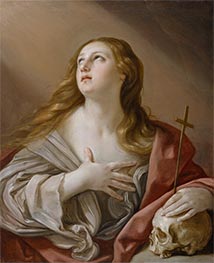
The Penitent Magdalene 1635
Oil Painting
$1231
$1231
Canvas Print
$60.41
$60.41
SKU: REG-3235
Guido Reni
Original Size: 90.8 x 74.3 cm
The Walters Art Museum, Baltimore, USA
Guido Reni
Original Size: 90.8 x 74.3 cm
The Walters Art Museum, Baltimore, USA

Drinking Bacchus c.1622
Oil Painting
$1057
$1057
SKU: REG-3236
Guido Reni
Original Size: 72 x 56 cm
Gemaldegalerie Alte Meister, Dresden, Germany
Guido Reni
Original Size: 72 x 56 cm
Gemaldegalerie Alte Meister, Dresden, Germany
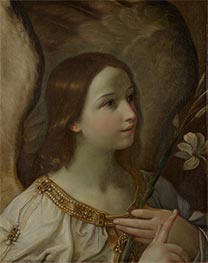
Angel of the Annunciation c.1628/29
Oil Painting
$1131
$1131
Canvas Print
$49.05
$49.05
SKU: REG-3237
Guido Reni
Original Size: 58.5 x 46.5 cm
Landesmuseum, Oldenburg, Germany
Guido Reni
Original Size: 58.5 x 46.5 cm
Landesmuseum, Oldenburg, Germany
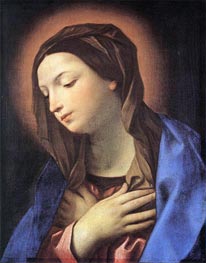
Virgin of the Annunciation n.d.
Oil Painting
$1131
$1131
SKU: REG-3238
Guido Reni
Original Size: unknown
Landesmuseum, Oldenburg, Germany
Guido Reni
Original Size: unknown
Landesmuseum, Oldenburg, Germany
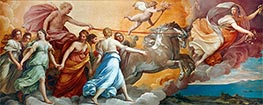
Aurora c.1615/18
Oil Painting
$4737
$4737
Canvas Print
$49.05
$49.05
SKU: REG-3239
Guido Reni
Original Size: 280 x 700 cm
Ralazzo Rospigliosi Pallavicini, Rome, Italy
Guido Reni
Original Size: 280 x 700 cm
Ralazzo Rospigliosi Pallavicini, Rome, Italy
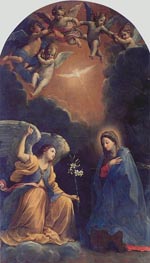
The Annunciation 1610
Oil Painting
$3058
$3058
SKU: REG-3242
Guido Reni
Original Size: unknown
Palazzo del Quirinale, Rome, Italy
Guido Reni
Original Size: unknown
Palazzo del Quirinale, Rome, Italy
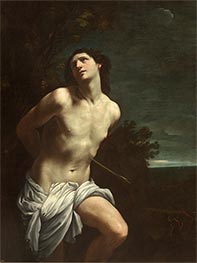
Saint Sebastian c.1617/18
Oil Painting
$1800
$1800
Canvas Print
$55.55
$55.55
SKU: REG-8233
Guido Reni
Original Size: 170 x 133 cm
Prado Museum, Madrid, Spain
Guido Reni
Original Size: 170 x 133 cm
Prado Museum, Madrid, Spain
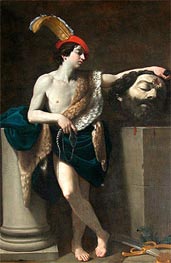
David with the Head of Goliath c.1604/06
Oil Painting
$2228
$2228
Canvas Print
$49.05
$49.05
SKU: REG-8234
Guido Reni
Original Size: 220 x 145 cm
Louvre Museum, Paris, France
Guido Reni
Original Size: 220 x 145 cm
Louvre Museum, Paris, France